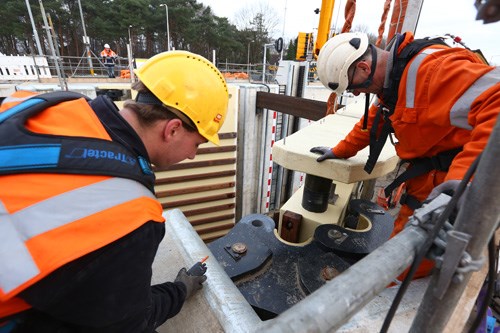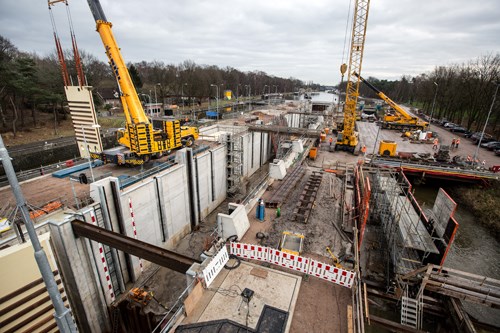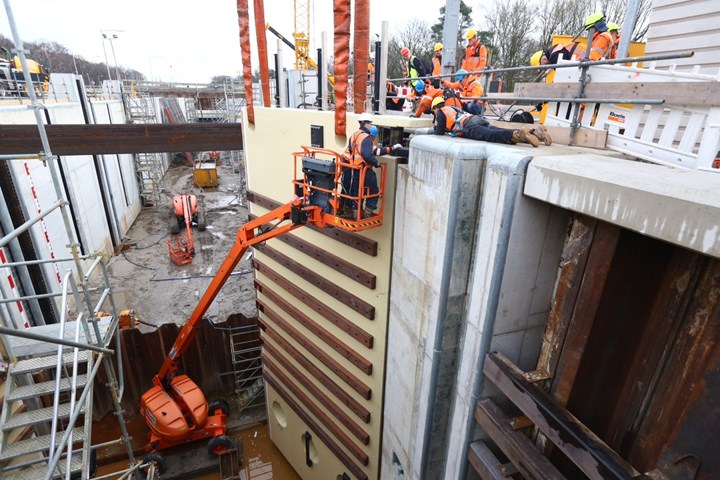Composites in a very large gate
The Wilhelmina Canal in Northern Europe is getting a major upgrade from massive (6.2m by 12.9m), lightweight (24 MT) composite doors that are designed for up to 80 years of continuous in-water service.
FiberCore Europe fabricated these composite lock gates on the Wilhelmina Canal in Tilburg, The Netherlands. The doors weigh 24 MT — 50% less than steel and 25% less than wood — and are designed for continuous water exposure for up to 80 years.
Canal lock gates are, in many ways, nearly ideal for the application of composites, benefitting tremendously from the material's durability, light weight, high strength and corrosion resistance. So, it was no surprise when, earlier this year, highly innovative composite lock gates were installed in the Wilhelmina Canal in Tilburg (The Netherlands) under direction of Heijmans. These huge lock gates (6.2m by 12.9m) were manufactured by FiberCore Europe (Rotterdam, The Netherlands) with resins from Aliancys AG (Schauffhausen, Switzerland). The installation was relatively easy, because of the low weight of the parts in comparison with steel and wood. The composite solution was chosen for its extended lifetime expectancy (more than 80 years), durability in continued contact with water and minimal maintenance.
The Wilhelmina Canal is an important water way in The Netherlands, and a vital part of the transportation infrastructure. In order to keep up with the increasing water traffic and increasing size of the ships (up to Class IV), the Wilhelmina Canal is being widened and deepened near the city of Tilburg. The project has been commissioned by the Dutch water way authorities (Rijkswaterstaat), and is executed by a combination of construction companies Heijmans and Boskalis. Installation of the lock gates was done by the construction company Hillebrand.

Pivot points for the doors benefit from the weight savings. Further, the specific gravity of the doors is close to that of water, which eases door movement compared to competitive materials.
After project completion, the large vessels should be able to sail through this section much faster. This means less heavy traffic on the roads, reduced road congestion and consequently reduced emissions of CO2 and particulates. The improvements to the canal will also create additional economic opportunities as businesses are increasingly using the canal network for delivery of products.
As part of the larger project, the existing locks II and III are replaced by a single new lock. Also, new sheet piling is installed along the canal sides and a more environmentally banks are being developed.
The composite parts were designed, engineered and manufactured by FiberCore Europe with Synolite 1967-G-9 resin from Aliancys, using InfraCore Inside technology. The large doors have a relatively low weight (24 MT), which is significantly less than comparable solutions in steel and wood (respectively 50% and 25% less). This makes the installation much easier, requiring simpler equipment and upfront preparation. Because the fact that the specific gravity of the door material is fairly close to that of water, wear and tear on pivoting points is greatly reduced.

The Wilhelmina Canal is being expanded to accommodate larger vessels and to enhance trade routes throughout The Netherlands.
“Lock gates in composite materials are highly competitive in terms of cost compared to traditional material solutions based on steel and wood,” explains Harald de Graaf, CEO of FiberCore Europe. “Steel and wood gates require repainting or treatment on a regular basis and for that purpose need to be removed from the lock (with an interrupted operation of the lock as a result). In many cases, wooden gates need to be replaced with new ones because the water will ultimately penetrate in the material and reduce mechanical properties.”
Related Content
Sustainable Infrastructure Systems creates fiber-reinforced post-consumer plastic structural panels
Australian composites manufacturer offers a scalable building solution, already established in a pedestrian bridge application, to tackle unprocessed soft plastics waste.
Read MoreFiberglass conduit manufacturer grows into new products, infrastructure applications
Texas-based Champion Fiberglass, a five-time CW Top Shops honoree, expands its success in the fiberglass composite conduit market into new applications and products, looking toward future automation and sustainability initiatives.
Read MoreComposite SIPs for more affordable, efficient and sustainable buildings
LiteSIP panels and modules enable framing in days, cutting structural labor and total cost by up to 70% and 30%, respectively, while increasing energy efficiency and durability.
Read MoreGatorbar, NEG, ExxonMobil join forces for composite rebar
ExxonMobil’s Materia Proxima polyolefin thermoset resin systems and glass fiber from NEG-US is used to produce GatorBar, an industry-leading, glass fiber-reinforced composite rebar (GFRP).
Read MoreRead Next
VIDEO: High-volume processing for fiberglass components
Cannon Ergos, a company specializing in high-ton presses and equipment for composites fabrication and plastics processing, displayed automotive and industrial components at CAMX 2024.
Read MorePlant tour: Daher Shap’in TechCenter and composites production plant, Saint-Aignan-de-Grandlieu, France
Co-located R&D and production advance OOA thermosets, thermoplastics, welding, recycling and digital technologies for faster processing and certification of lighter, more sustainable composites.
Read MoreAll-recycled, needle-punched nonwoven CFRP slashes carbon footprint of Formula 2 seat
Dallara and Tenowo collaborate to produce a race-ready Formula 2 seat using recycled carbon fiber, reducing CO2 emissions by 97.5% compared to virgin materials.
Read More

























